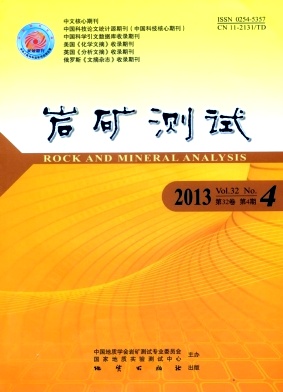| [1] |
汪凯明,罗顺社.海相碳酸盐岩锶同位素及微量元素特征与海平面变化[J].海洋地质与第四纪地质,2009,29(6): 51-58.
Google Scholar
|
| [2] |
熊小辉,肖加飞.沉积环境的地球化学示踪[J].地球与环境,2011, 39(3): 405-414.
Google Scholar
|
| [3] |
刘刚,周东升.微量元素分析在判别沉积环境中的应用——以江汉盆地潜江组为例[J].石油实验地质,2007, 29(3): 307-310. doi: 10.11781/sysydz200703307
CrossRef Google Scholar
|
| [4] |
王随继,黄杏珍.泌阳凹陷核桃园组微量元素演化特征及其古气候意义[J].沉积学报, 1997, 15(1): 65-70.
Google Scholar
|
| [5] |
常华进,储雪蕾,冯连君,黄晶,张启锐.氧化还原敏感微量元素对古海洋沉积环境的指示意义[J].地质论评,2009,55(1): 91-99.
Google Scholar
|
| [6] |
Strakhov N M.The types of iron in sediments of the Black Sea [J].Doklady Akademii Nauk Sssr,1958,118(4): 803-806.
Google Scholar
|
| [7] |
Nicholls G D.Trace elements in sediments: An assess-ment of their possible utility as depth indicators [J]. Marine Geology,1967, 5(5): 539-555.
Google Scholar
|
| [8] |
严兆彬,郭福生,潘家永,郭国林,张日静.碳酸盐岩C,O,Sr同位素组成在古气候、古海洋环境研究中的应用[J].地质找矿论丛,2005,20(1): 53-65.
Google Scholar
|
| [9] |
Magaritz M, Holser W T, Kirschvink J L. Carbon-isotope events across the Precambrian/Cambrian boundary on the Siberian Platform [J].Nature,1986,320: 258-259. doi: 10.1038/320258a0
CrossRef Google Scholar
|
| [10] |
王大锐,白玉雷,赵治信.塔里木盆地海相古生界化学地层学研究[J].石油勘探与开发,1999,26(1):18-20.
Google Scholar
|
| [11] |
高志前,樊太亮,李岩,刘武宏,陈玉林.塔里木盆地寒武-奥陶纪海平面升降变化规律研究[J].吉林大学学报:地球科学版,2006, 36(4):549-556.
Google Scholar
|
| [12] |
Scherer M, Seitz H.Rare-earth element distribution in Holocene and Pleistocene corals and their redistribution during diagenesis [J].Chemical Geology,1980,28: 279-289. doi: 10.1016/0009-2541(80)90049-2
CrossRef Google Scholar
|
| [13] |
Webb G E, Kamber B S.Rare earth elements in Holo-cene reefal microbialites: A new shallow seawater proxy[J].Geochimica et Cosmochimica Acta,2000,64(9): 1557-1565. doi: 10.1016/S0016-7037(99)00400-7
CrossRef Google Scholar
|
| [14] |
Shields G, Webb G. Has the REE composition of sea-water changed over geological time [J].Chemical Geology,2004,204: 103-107. doi: 10.1016/j.chemgeo.2003.09.010
CrossRef Google Scholar
|
| [15] |
Rongemaille E, Bayon G, Pierre C, Chu N C, Fouquet Y, Riboulot V, Voisset M.Rare earth elements in cold seep carbonates from the Niger delta[J].Chemical Geology,2011,286: 196-206.
Google Scholar
|
| [16] |
Zhao Y Y, Zheng Y F, Chen F K.Trace element and strontium isotope constraints on sedimentary environment of Ediacaran carbonates in southern Anhui, South China [J].Chemical Geology,2009,265(3): 345-362.
Google Scholar
|
| [17] |
黄晶,储雪蕾,常华进,冯连君.三峡地区埃迪卡拉系陡山沱组帽碳酸盐岩的微量元素和稀土元素研究[J].科学通报,2009,54(22): 3498-3506.
Google Scholar
|
| [18] |
Tessier A, Campbell P G, Bisson M.Sequential extrac-tion procedure for the speciation of particulate trace metals [J].Analytical Chemistry,1979, 51(7): 844-851. doi: 10.1021/ac50043a017
CrossRef Google Scholar
|
| [19] |
李非里,刘丛强,宋照亮.土壤中重金属形态的化学分析综述[J].中国环境监测,2005,21(4): 21-27.
Google Scholar
|







 DownLoad:
DownLoad:

